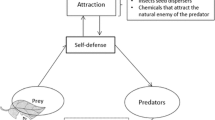Abstract
The biological pest control in agriculture, an environment-friendly practice, maintains the density of pests below an economic injury level by releasing a suitable quantity of their natural enemies. This work proposes a multi-objective numerical solution to biological pest control for soybean crops, considering both the cost of application of the control action and the cost of economic damages. The system model is nonlinear with impulsive control dynamics, in order to cope more effectively with the actual control action to be applied, which should be performed in a finite number of discrete time instants. The dynamic optimization problem is solved using the NSGA-II, a fast and trustworthy multi-objective genetic algorithm. The results suggest a dual pest control policy, in which the relative price of control action versus the associated additional harvest yield determines the usage of either a low control action strategy or a higher one.
Similar content being viewed by others
References
Bertsekas, D.P., 1995. Dynamic Programming and Optimal Control. Athena Scientific, Nashua.
Bertsekas, D.P., 2005. Dynamic programming and suboptimal control: a survey from ADP to MPC. Eur. J. Control. 11(4–5), 310–334.
Bor, Y.J., 2003. Uncertain control of dynamic economic threshold in pest management. Agric. Syst. 78, 105–118.
Burden, R.L., Faires, J.D., 2003. Numerical Analysis. Thomson, Belmont.
Caltagirone, L.E., Doutt, R.L., 1989. The history of the vedalia beetle importation to California and its impact on the development of biological control. Ann. Rev. Entomol. 34, 01–16.
Cardoso, R.T.N., Takahashi, R.H.C., Fonseca, C.M., 2009. An open-loop invariant-set approach for multiobjective dynamic programming problems. In: Proceedings of the IFAC Workshop on Control Applications of Optimization, Jyvaskyla, Finland, May 2009. IFAC.
Dar’in, A.N., Kurzhanskii, A.B., Selesznev, A.V., 2005. The dynamic programming method in impulsive control synthesis. Ordinary Differ. Equ. 41(11), 1491–1500.
Darwin, C.R., 1882. The Variation of Animals and Plants under Domestication. Murray, London.
Deb, K., Agrawal, S., Pratab, A., Meyarivan, T., 2000. A fast elitist non-dominated sorting genetic algorithm for multi-objective optimization: NSGA-II. In: Proceedings of the VI Conference in Parallel Problem Solving from Nature, Lecture Notes in Computer Science, vol. 1917, pp. 849–858. Springer, Berlin
DeBach, P., 1964. Biological Control of Insects Pests and Weeds. Van Nostrand-Rheinhold, New York.
DeBach, P., 1991. Biological Control by Natural Enemies. Cambridge University Press, Cambridge.
Feltrin, C.C., Rafikov, M., 2002. Aplicação da função de Lyapunov num problema de controle ótimo de pragas. Tend. Mat. Apl. Comput. 3(2), 83–92 (in portuguese).
Freeman, R., Primbs, J., 1996. Control Lyapunov functions: New ideas from and old sources. In: Proceedings of the 35th IEEE Conference on Decision and Control, pp. 3926–3931.
Goldberg, D.E., 1989. Genetic Algorithms in Search, Optimization and Machine Learning. Addison-Wesley, Reading.
Griffiths, G.J.K., Holland, J.M., Bailey, A., Thomas, M.B., 2008. Efficacy and economics of shelter habitats for conservation biological control. Biol. Control 45(2), 200–209.
Holland, J.H., 1962a. Concerning efficient adaptive systems. In: Yovits, M.C., Jacobi, G.T., Goldstein, G.D. (Eds.), Self-Organizing Systems, pp. 215–230. Spartan Books, Washington
Holland, J.H., 1962b. Outline for a logical theory of adaptive systems. J. Assoc. Comput. Mach. 9, 297–314.
Holland, J.H., 1975. Adaptation in Natural and Artificial Systems. University of Michigan Press, Ann Arbor.
Liu, B., Teng, Z., Chen, L., 2006. Analysis of a predator–prey model with Holling II functional response concerning impulsive control strategy. J. Comput. Appl. Math. 193(2), 347–362.
Rafikov, M., Balthazar, J.M., 2005. Optimal pest control problem in population dynamics. Comput. Appl. Math. 24(1), 65–81.
Srinivas, N., Deb, K., 1994. Multi-objective optimization using nondominated sorting in genetic algorithms. Evol. Comput. 2(3), 221–248.
Tang, S., Xiao, Y., Chen, L., Cheke, R., 2005. Integrated pest management models and their dynamical behavior. Bull. Math. Biol. 67, 115–135.
Yang, T., 1999. Impulsive control. IEEE Trans. Automat. Contr. 44(5), 1081–1083.
Yang, T., 2001. Impulsive Control Theory. Springer, New York.
Zhang, H., Jiao, J., Chen, L., 2007. Pest management through continuous and impulsive control strategies. BioSystems 90, 350–361.
Author information
Authors and Affiliations
Corresponding author
Rights and permissions
About this article
Cite this article
Cardoso, R.T.N., da Cruz, A.R., Wanner, E.F. et al. Multi-Objective Evolutionary Optimization of Biological Pest Control with Impulsive Dynamics in Soybean Crops. Bull. Math. Biol. 71, 1463–1481 (2009). https://doi.org/10.1007/s11538-009-9409-7
Received:
Accepted:
Published:
Issue Date:
DOI: https://doi.org/10.1007/s11538-009-9409-7




